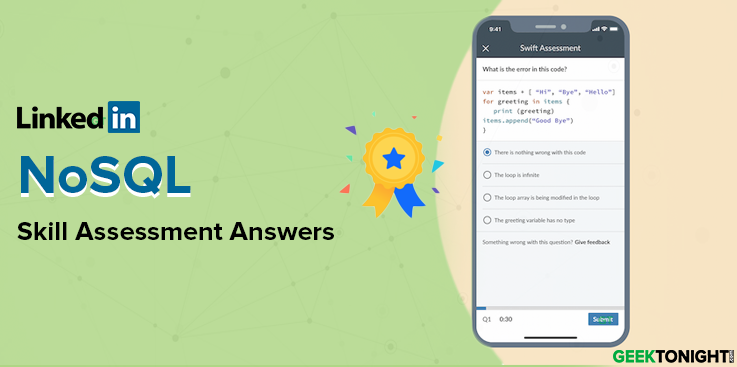The LinkedIn Skill Assessments feature allows you to demonstrate your knowledge of the skills you’ve added on your profile. Job posters on LinkedIn can also add Skill Assessments as part of the job application process. This allows job posters to more efficiently and accurately verify the crucial skills a candidate should have for a role.

The topics in the NoSQL assessment include:
- Using NoSQL
- NoSQL Concepts
- NoSQL Applications
- Core NoSQL
- Optimizing NoSQL
Question Format
Multiple Choice
Language
English
Table of Content
- 1 LinkedIn NoSQL Skill Assessment Answers
- 1.1 Which types of indexes are available in CosmosDB?
- 1.2 You want to connect a DynamoDB stream to AWS Lambda function?
- 1.3 To index a field that holds an array value in MongoDB, which index type do you create?
- 1.4 You want to test HBASE on your laptop using the fewest number of steps. What do you do?
- 1.5 You need to create a document database that supports database triggers. Which NoSQL database should you use?
- 1.6 What is recommended size for Redis keys?
- 1.7 You need to design security for DynamoDB to allow users read-only access to certain items and attributes in a table. What do you do?
- 1.8 What does redis use to sort the elements of a sorted set?
- 1.9 You need to change the shard key of an existing MongoDB collection. What do you do?
- 1.10 Polyglot storage means using multiple types of what in the same application?
- 1.11 You need to implement the simplest possible scalable, in-memory cache for your AWS application. Which service do you select?
- 1.12 You are doing data modelling for Google BigTable. Which statement expresses if and when you should split entities across multiple rows?
- 1.13 Which two characteristics define Amazon Quantum Ledger Database?
- 1.14 You need to design the primary key for DynamoDB based on three attributes. What do you do?
- 1.15 You need to design the primary key for DynamoDB based on three attributes. What do you do?
- 1.16 Which of these data types should you avoid in designing a Google Bigtable row key?
- 1.17 Your startup is building a prototype that has an evolving schema. Your data will be eventually consistent. Your application is hosted in AWS. Which databse do you choose?
- 1.18 You need to create a scalable databse that allows you to share documents across authorized mobile clients in real time. What Google NoSQL database should you use?
- 1.19 You want to test HBase on your laptop using the fewest number of steps. What do you do?
- 1.20 You need to design security for DynamoDB to allow users read-obly access to certain items and attriutes in a table. What do you do?
- 1.21 You need to design a primary key for DynamoDb based on three attributes. What do you do?
- 1.22 What does Redis use to sort the elements of a sorted set?
- 1.23 You need to create a document database that supports database triggers. Which NoSQL database should you use?
- 1.24 Which statement is prefered Cypher code for Neo4j?
- 1.25 You need multi-item ACID transactions with snapshot isolation within a partition for your cloud-based application. Which NoSQL databse do you choose?
- 1.26 You need to control your application’s batch updates destination for your Bigtable multinode cluster. Which action do you take?
- 1.27 Polyglot storage mean using multiple types of what in the same application?
- 1.28 Your query to verify that your Redis key is configured to support expiring user information on a defined interval returns -2, What does this value indicate?
- 1.29 You are designing a MongoDB schema to support queries that will include lookups. What should you do?
- 1.30 What is the aggregation operator for a join concept in MongoDB?
- 1.31 For your mobile application, you need to select a Google cloud databse that can support compound, filtered document queries. Which do you choose?
- 1.32 To bulk load data into Amazon Neputn, what do you do?
- 1.33 You need to create a pub/sub server. Which databse do you use?
- 1.34 You want to connect a DynamoDb stream to an AWS lamdba function. Which one of these object do you create.
- 1.35 Which two types of indexes are available in Cosmos DB?
- 1.36 SQL databses and NoSQL are which types of scalable?
- 1.37 You need to create a scalable database that allows you to query data nodes and edges efficiently. What do you use?
- 1.38 You are developing a model for a graph database. Your data will be moved from a relational database into Neo4j. Which of these transformations apply?
- 1.39 To index a field that holds an array value in MongoDB, which index type do you create?
- 1.40 You need to execute a command for MongoDB that does NOT load values from the .mongorc.js file. What do you do ?
- 1.41 What is the recommended size for Redis keys?
- 1.42 You need to store an unordered collection of name-value pairs with differing data types in DynamoDB. Which data type should you choose?
- 1.43 Which statement retrieves an item from the MusicCollection table in DynamoDB?
- 1.44 Database availability is measured by which metric?
- 1.45 You need to encrypt data at rest in DynamoDB. Which action do you take?
- 1.46 You need to generate a unique, sequential identifier for each value stored in a Redis cluster. What do you do?
- 1.47 You want to return a list of all elements in two Redis sets. Which keyword do you use?
- 1.48 Which method shows you whether MongoDB uses any indexes when running a query, and how the indexes are used?
- 1.49 Which statement accurately describes global secondary indexes in DynamoDB?
- 1.50 Which command do you use to add a value to a Redis stream named mystream?
- 1.51 Which code example completes this statement and creates an index for a MongoDB object named restaurants, sorted ascending by the field name?
- 1.52 Which Cypher code executes the multiquery block?
- 1.53 You need to create a scalable database that supports immutable writes. What do you use?
- 1.54 You need to create a data store for the catalog for your new ecommerce application. Your company is a startup, so the catalog schema may evolve. Which do you choose?
- 1.55 You need to select a NoSQL database for heavy aggregate query workloads. Which type do you choose?
- 1.56 You need to select a columnstore database that enforce built-in data types. You want to add indexes to improve performance for known workloads. Which do you choose?
- 1.57 In DynamoDB, the partition key and sort key are also known as which type of attributes?
- 1.58 What is a popular, open-source key-value store database?
- 1.59 You need to create a scalable database to store and query JSON data. What do you use?
LinkedIn NoSQL Skill Assessment Answers
Which types of indexes are available in CosmosDB?
- range and spatial
- secondary and primary key
- secondary and spatial
- range and primary key
You want to connect a DynamoDB stream to AWS Lambda function?
- DynamoDB table
- DynamoDB trigger
- DynamoDB item
- DynamoDB index
To index a field that holds an array value in MongoDB, which index type do you create?
- partial
- sparse
- compound
- multikey
You want to test HBASE on your laptop using the fewest number of steps. What do you do?
- Set up Hadoop in pseudo-distributed mode.
- Set up HBASE in local mode.
- Set up HBASE in pseudo-distributed mode.
- Set up Hadoop in local mode.
You need to create a document database that supports database triggers. Which NoSQL database should you use?
- DynamoDB
- BigTable
- Redis
- MongoDB
What is recommended size for Redis keys?
- medium
- short
- single bit
- long
You need to design security for DynamoDB to allow users read-only access to certain items and attributes in a table. What do you do?
- Use lAM policy conditions
- Use lAM roles
- Use VPC endpoint
- Use lAM policies
What does redis use to sort the elements of a sorted set?
- Scores.
- Ids.
- Values.
- Keys
You need to change the shard key of an existing MongoDB collection. What do you do?
- Dump the collection data, drop the collection, create a new collection and shard key, import the data.
- Add second shard key and drop the first shard key.
- Dump the collection data, drop the collection, presplit the data, create a new collection and shard key, import the data.
- Drop and recreate the shard key.
Polyglot storage means using multiple types of what in the same application?
- Security systems.
- Database systems.
- Storage systems.
- Query systems.
You need to implement the simplest possible scalable, in-memory cache for your AWS application. Which service do you select?
- Elasticache using Memcached.
- DynamoDB.
- DynamoDB Accelerator (DAX).
- Elasticache using Redis.
You are doing data modelling for Google BigTable. Which statement expresses if and when you should split entities across multiple rows?
- Keep all information for an entity in a single row. Store related entities in adjacent rows.
- Keep all information for an entity in a single row.
- Split entities across multiple rows if the entity data is over thousands of MBs, or if it does not need atomic updates and reads.
- Split entities across multiple rows if the entity data is over hundreds of MBs, or if it does not need atomic updates and reads.
Which two characteristics define Amazon Quantum Ledger Database?
- Key-value data model; transactionally consistent with ACID semantics.
- Document data model; transactionally consistent with ACID semantics.
- Key-value data model; transactions with tunable consistency.
- Document data model; transactions with tunable consistency.
You need to design the primary key for DynamoDB based on three attributes. What do you do?
- Designate all three fields as the primary key.
- Concatenate all three fields into one new field, then designate that new field as the primary key.
- Designate two fields of the three fields as the primary key.
- Concatenate two fields into one new field, then designate that new field and the remaining field as the primary key.
You need to design the primary key for DynamoDB based on three attributes. What do you do?
- Designate all three fields as the primary key.
- Concatenate all three fields into one new field, then designate that new field as the primary key.
- Designate two fields of the three fields as the primary key.
- Concatenate two fields into one new field, then designate that new field and the remaining field as the primary key.
Which of these data types should you avoid in designing a Google Bigtable row key?
- multi-valued identifiers
- string identifiers
- timesstamps
- frequently updated identifiers
Your startup is building a prototype that has an evolving schema. Your data will be eventually consistent. Your application is hosted in AWS. Which databse do you choose?
- Neptune
- DocumentDB
- DynamoDB
- Amazon Aurora
- Memorystore
- Datastore
- Firebase
- Bigtable
You want to test HBase on your laptop using the fewest number of steps. What do you do?
- Set up HBase in local mode.
- Set up Hadoop in pseudo-distributed mode.
- Set up HBase in pseudo-distributed mode.
- Set up Hadoop in local mode.
You need to design security for DynamoDB to allow users read-obly access to certain items and attriutes in a table. What do you do?
- Use IAM roles.
- Use IAM plicy conditions.
- Use a VPC endpoint.
- Use IAM plicies.
You need to design a primary key for DynamoDb based on three attributes. What do you do?
- Concatenate all three fields into into one new field, than disignate that new field as the primary key.
- Concatenate two fileds into one new field, than disignate that new field and the remaining field as the primary key.
- Designate all three fields as the primary key.
- Designate two filds of the three fields as the primary key.
What does Redis use to sort the elements of a sorted set?
- keys
- values
- scroes
- ids
You need to create a document database that supports database triggers. Which NoSQL database should you use?
- DynamoDb
- Redis
- MongoDB
- Bigtable
Which statement is prefered Cypher code for Neo4j?
- MATCH (:Person)–>(:Card)–>(:Company) RETURN count(vehicle)
- Match (:Person)–>(:Car):(vehicle:Car)–>(:Company) RETURN count(vehicle)
- MATCH (:Person)–>(vehicle:Car)–>(:Company) RETURN count(vehicle)
- MATCH (:Person)–>(:Card), (vehicle:Car)–>(:Company) RETURN count(vehicle)
You need multi-item ACID transactions with snapshot isolation within a partition for your cloud-based application. Which NoSQL databse do you choose?
- Bigtable
- GraphDB
- DynamoDB
- Cosmos DB
You need to control your application’s batch updates destination for your Bigtable multinode cluster. Which action do you take?
- Create a custom app profile to route batch updates.
- Create a custom app profile to route the batch update from that client.
- Update the default app profile to route the natch update from that client.
- Use the default app profile to route batch updates.
Polyglot storage mean using multiple types of what in the same application?
- security systems
- databse systems
- query systems
- storage systems
Your query to verify that your Redis key is configured to support expiring user information on a defined interval returns -2, What does this value indicate?
- The queried key value expired in the last two secodns.
- The queried key value exists, but has no associated expire value.
- The queried key value does not exist.
- There are two expired keys with this value.
You are designing a MongoDB schema to support queries that will include lookups. What should you do?
- Create an index on the key value used as the primary key.
- Create an index on the key value used as the foreign key.
- Create a multicolumn index on the key value used as the foreign key and the most unique column in the document.
- Create a multicolumn index on the key value used as the primary and also the forign key.
What is the aggregation operator for a join concept in MongoDB?
- $group
- $match
- $lookup
- $project
For your mobile application, you need to select a Google cloud databse that can support compound, filtered document queries. Which do you choose?
- Cloud SQL
- Cloud Spanner
- Cloud Firestore
- Cloud Firebase
To bulk load data into Amazon Neputn, what do you do?
- Upload data to S3 VPC endpoint, Use the Neptun loader to load from s3 into your Neptune instance
- Ad data to a Kinesis stream, and use the Neptune loade to load from S# into your Neptun instance.
- Add data to a Kisnesis stream, and create a Kinesis stream VPC endpoint. Use the Nepune loader to load from S3into your Neptune instance.
- Upload data to S Use the neptune loader to load from S3 into your Neptune instance.
You need to create a pub/sub server. Which databse do you use?
- Neo4j
- Cassandra
- Redis
- MySQL
You want to connect a DynamoDb stream to an AWS lamdba function. Which one of these object do you create.
- DynamoDb table
- DynamoDB trigger
- DynamoDB item
- DYnamoDB index
Which two types of indexes are available in Cosmos DB?
- secondery and primary key
- secondary and spatial
- range and spatial
- range and primary key
SQL databses and NoSQL are which types of scalable?
- horizontally, infinitely
- vertically, horizontally
- vertically, infinitely
- horizonally, vertically
You need to create a scalable database that allows you to query data nodes and edges efficiently. What do you use?
- a relational databse
- a columnstore databse
- a document databse
- a graph database
You are developing a model for a graph database. Your data will be moved from a relational database into Neo4j. Which of these transformations apply?
- Rows become labes: bales become nodes.
- Tables become labels: rows become nodes.
- Tables become collections: rows become items.
- Rows become collections: tables become items.
To index a field that holds an array value in MongoDB, which index type do you create?
- sparse
- compound
- partial
- multikey
You need to execute a command for MongoDB that does NOT load values from the .mongorc.js file. What do you do ?
- Delete the .monorc.js file and restart mongo shell.
- Use the mongo shell to create a command with –norc option
- Rem all lines in the .mongorc.js file ad restart mongo shell.
- Use the mongo shell to create a command with –nodedefault option.
What is the recommended size for Redis keys?
- long
- short
- medium
- a single bit
You need to store an unordered collection of name-value pairs with differing data types in DynamoDB. Which data type should you choose?
- map
- set
- list
- stack
Which statement retrieves an item from the MusicCollection table in DynamoDB?
- aws dynamodb query –table-name MusicCollection –key file://key.json
- aws dynamodb get-item –table-name MusicCollection –key file://key.json
- aws dynamodb select –table-name MusicCollection –key file://key.json
- aws dynamodb put-item –table-name MusicCollection –key file://key.json
Database availability is measured by which metric?
- the amount of service calls
- the number of minutes
- the amount of service costs
- the number of nines
You need to encrypt data at rest in DynamoDB. Which action do you take?
- You assign a default AWS encryption key to your table to encrypt data.
- You create an AWS encryption key and assign it to your table to encrypt data.
- None. Data is encrypted by default.
- You create an AWS encryption key and assign it to your database to encrypt data.
You need to generate a unique, sequential identifier for each value stored in a Redis cluster. What do you do?
- Implement a SortedSet object to generate a value.
- Use the GUID keyword to generate a value.
- Implement a List object to generate a value.
- Use the INCR keyword to generate a value
You want to return a list of all elements in two Redis sets. Which keyword do you use?
- smembers
- returnall
- sunion
- sismember
Which method shows you whether MongoDB uses any indexes when running a query, and how the indexes are used?
- detailQueryExecution()
- showPlan()
- explain()
- describe()
Which statement accurately describes global secondary indexes in DynamoDB?
- The global secondary indexes in DynamoDB are consistent, and are not guaranteed to return correct results.
- The global secondary indexes in DynamoDB are transactionally consistent, and are guaranteed to return correct results.
- The global secondary indexes in DynamoDB are partially consistent, and are not guaranteed to return correct results.
- The global secondary indexes in DynamoDB are eventually consistent, and are not guaranteed to return correct results.
Which command do you use to add a value to a Redis stream named mystream?
- ADD mystream * sensor-id 1234 temperature 19.8 1518951480106-1
- UPDATE mystream * sensor-id 1234 temperature 19.8 1518951480106-3
- XADD mystream * sensor-id 1234 temperature 9.8 1518951480106-0
- INSERT mystream * sensor-d 1234 temperature 19.8 15181480106-2
Which code example completes this statement and creates an index for a MongoDB object named restaurants, sorted ascending by the field name?
var indexCollection = function(db) {return co(function() {…});};*
- const results = yield db.table(‘restaurants’).createIndex({“name”: 1}, null); return results;
- const results = yield db.collection(‘restaurants’).createIndex({“name”: 0}, null); return results;
- const results = yield db.collection(‘restaurants’).createIndex({“name”: 1}, null); return results;
- const results = yield db.table(‘restaurants’).createIndex({“name”: 0}, null); return results;
Which Cypher code executes the multiquery block?
- A
MATCH (c:Company {name: ‘Neo4j’}) RETURN c, MATCH (p:Person) WHERE p.name = ‘Jennifer’ RETURN p,
MATCH (t:Technology)-[:LIKES]-(a:Person {name: ‘Jennifer’}) RETURN t.type; - B
MATCH (c:Company {name: ‘Neo4j’}) RETURN c, MATCH (p:Person) WHERE p.name = ‘Jennifer’ RETURN p,
MATCH (t:Technology)-[:LIKES]-(a:Person {name: ‘Jennifer’}) RETURN t.type - C
MATCH (c:Company {name: ‘Neo4j’}) RETURN c AND MATCH (p:Person) WHERE p.name = ‘Jennifer’ RETURN p,
AND MATCH (t:Technology)-[:LIKES]-(a:Person {name: ‘Jennifer’}) RETURN t.type; - D
MATCH (c:Company {name: ‘Neo4j’}) RETURN c;MATCH (p:Person) WHERE p.name = ‘Jennifer’ RETURN p;
MATCH (t:Technology)-[:LIKES]-(a:Person {name: ‘Jennifer’}) RETURN t.type;
You need to create a scalable database that supports immutable writes. What do you use?
- A ledger database
- A graph database
- A key-value database
- A columnstore database
You need to create a data store for the catalog for your new ecommerce application. Your company is a startup, so the catalog schema may evolve. Which do you choose?
- Neo4j
- Redis
- MySQL
- MongoDB
You need to select a NoSQL database for heavy aggregate query workloads. Which type do you choose?
- graph
- key-value
- document
- columnstore
You need to select a columnstore database that enforce built-in data types. You want to add indexes to improve performance for known workloads. Which do you choose?
- Cassandra
- Bigtable
- Redis
- HBase
In DynamoDB, the partition key and sort key are also known as which type of attributes?
- range, hash
- primary, range
- hash, range
- range, secondary
What is a popular, open-source key-value store database?
- MongoDB
- Redis
- MySQL
- Cassandra
You need to create a scalable database to store and query JSON data. What do you use?
- a relational database
- a document database
- a graph database
- a ledger database
All Linkedin Skill Assessment Answers
List of Technical Skill Assessment
- LinkedIn .NET Framework Skill Assessment Quiz Answers
- LinkedIn Agile Methodologies Skill Assessment Quiz Answers
- LinkedIn Amazon Web Services (AWS) Skill Quiz Answers
- LinkedIn Android Assessment Quiz Answers
- LinkedIn AngularJS Skill Assessment Quiz Answers
- LinkedIn AWS Lambda Skill Assessment Answers
- LinkedIn Bash Skill Assessment Quiz Answers
- LinkedIn C Skill Assessment Quiz Answers
- LinkedIn C# Skill Assessment Quiz Answers
- LinkedIn C++ Skill Assessment Quiz Answers
- LinkedIn CSS Skill Assessment Quiz Answers
- LinkedIn Cyber Security Skill Assessment Quiz Answers
- LinkedIn Django Skill Assessment Quiz Answers
- LinkedIn Eclipse Skill Assessment Quiz Answers
- LinkedIn Front End Development Skill Assessment Quiz Answers
- LinkedIn Git Skill Assessment Quiz Answers
- LinkedIn Google Analytics Skill Assessment Quiz Answers
- LinkedIn Google Cloud Platform (GCP) Skill Assessment Quiz Answers
- LinkedIn Hadoop Skill Assessment Quiz Answers
- LinkedIn HTML Skill Assessment Quiz Answers
- LinkedIn IT Operation Skill Assessment Quiz Answers
- LinkedIn Java Skill Assessment Quiz Answers
- LinkedIn JavaScript Skill Assessment Quiz Answers
- LinkedIn JQuery Skill Assessment Quiz Answers
- LinkedIn JSON Skill Assessment Quiz Answers
- LinkedIn Windows Server Skill Assessment Quiz Answers
- LinkedIn XML Skill Assessment Answers
- LinkedIn Kotlin Skill Assessment Quiz Answers
- LinkedIn Linux Skill Assessment Quiz Answers
- LinkedIn Machine Learning Skill Assessment Quiz Answers
- LinkedIn Maven Skill Assessment Quiz Answers
- LinkedIn Microsoft Azure Skill Assessment Quiz Answers
- LinkedIn MongoDB Skill Assessment Quiz Answers
- LinkedIn MySQL Skill Assessment Quiz Answers
- LinkedIn Node JS Skill Assessment Quiz Answers
- LinkedIn NoSQL Skill Assessment Quiz Answers
- LinkedIn Objective-C Skill Assessment Quiz Answers
- LinkedIn OOP (Object-Oriented Programming Skill Assessment Quiz Answers
- LinkedIn PHP Skill Assessment Quiz Answers
- LinkedIn Python Skill Assessment Quiz Answers
- LinkedIn React JS Skill Assessment Quiz Answers
- LinkedIn Rest APIs Skill Assessment Quiz Answers
- LinkedIn R (Programming Language) Skill Assessment Quiz Answers
- LinkedIn Ruby on Rails Skill Assessment Quiz Answers
- LinkedIn Scala Skill Assessment Quiz Answers
- LinkedIn Search Engine Optimization (SEO) Skill Assessment Quiz Answers
- LinkedIn Spring Framework Skill Assessment Quiz Answers
- LinkedIn Swift Skill Assessment Quiz Answers
- LinkedIn T-SQL Skill Assessment Quiz Answers
- LinkedIn Unity Skill Assessment Quiz Answers
- LinkedIn Visual Basic for Application (VBA) Skill Assessment Quiz Answers
- LinkedIn WordPress Skill Assessment Quiz Answers
List of Business Skill Assessment
- LinkedIn Accounting Skill Assessment Quiz Answers
- LinkedIn Adobe Acrobat Skill Assessment Quiz Answers
- LinkedIn Google Ads Skill Assessment Quiz Answers
- LinkedIn Microsoft Access Skill Assessment Quiz Answers
- LinkedIn Microsoft Excel Skill Assessment Quiz Answers
- LinkedIn Microsoft Outlook Skill Assessment Quiz Answers
- LinkedIn Microsoft Power BI Skill Assessment Quiz Answers
- LinkedIn Microsoft PowerPoint Skill Assessment Quiz Answers
- LinkedIn Microsoft Project Skill Assessment Quiz Answers
- LinkedIn Microsoft Word Skill Assessment Quiz Answers
- LinkedIn SharePoint Skill Assessment Quiz Answers
- LinkedIn Visio Skill Assessment Quiz Answers
List of Design Skill Assessment















